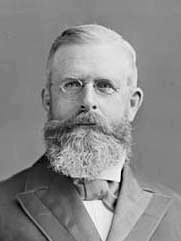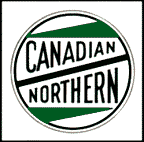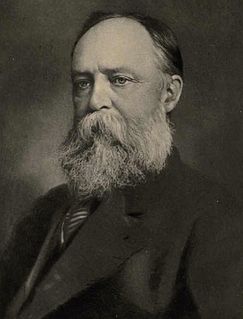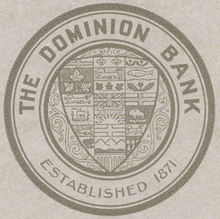
The Toronto Stock Exchange is a stock exchange located in Toronto, Ontario, Canada. It is the 11th largest exchange in the world and the third largest in North America based on market capitalization. Based in the EY Tower in Toronto's Financial District, the TSX is a wholly owned subsidiary of the TMX Group for the trading of senior equities. A broad range of businesses from Canada and abroad are represented on the exchange. In addition to conventional securities, the exchange lists various exchange-traded funds, split share corporations, income trusts and investment funds. More mining and oil and gas companies are listed on Toronto Stock Exchange than any other stock exchange.

Sir William Mulock, was a Canadian lawyer, businessman, educator, farmer, politician, judge, and philanthropist. He served as vice-chancellor of the University of Toronto from 1881 to 1900, negotiating the federation of denominational colleges and professional schools into a modern university.

CT Financial Services Inc., operating as Canada Trust, was a financial services holding company headquartered in Toronto, Ontario, which operated in Canada through its trust company subsidiaries, including Canada Trustco Mortgage Company and The Canada Trust Company.

The Bank of Montreal is a Canadian multinational investment bank and financial services company.

The Toronto-Dominion Bank is a Canadian multinational banking and financial services corporation headquartered in Toronto, Ontario. Commonly known as TD and operating as TD Bank Group, the bank was created on 1 February 1955, through the merger of the Bank of Toronto and The Dominion Bank, which were founded in 1855 and 1869, respectively. It is one of two Big Five banks founded in Toronto, the other being the Canadian Imperial Bank of Commerce. The Toronto-Dominion Bank swift code is TDOMCATTTOR and the TD institution number is 004.

The Toronto-Dominion Centre, or TD Centre, is an office complex in the Financial District of downtown Toronto owned by Cadillac Fairview. It serves as the global headquarters for its anchor tenant, the Toronto-Dominion Bank, and provides office and retail space for many other businesses. The complex consists of six towers and a pavilion covered in bronze-tinted glass and black painted steel. Approximately 21,000 people work in the complex, making it the largest commercial office complex in Canada.
Royal Bank of Canada is a Canadian multinational financial services company and the largest bank in Canada by market capitalization. The bank serves over 16 million clients and has 86,000+ employees worldwide. Founded in 1864 in Halifax, Nova Scotia, it maintains a corporate headquarters in Toronto and its head office in Montreal. RBC's institution number is 003. In November 2017, RBC was added to the Financial Stability Board's list of global systemically important banks.

The Canadian Northern Railway (CNoR) was a historic Canadian transcontinental railway. At its 1923 merger into the Canadian National Railway, the CNoR owned a main line between Quebec City and Vancouver via Ottawa, Winnipeg, and Edmonton.

The Union Bank of Halifax was granted a charter by the government of Canada in 1856 and established its head office at the corner of Hollis and Prince Streets in the port city of Halifax, Nova Scotia.

TD Waterhouse Canada Inc. is a Canadian financial services corporation headquartered in Toronto, Ontario and owned by Toronto-Dominion Bank. The company does business through several divisions, TD Direct Investing, TD Wealth Financial Planning, and TD Wealth Private Investment Advice. The TD Waterhouse brand was also formerly used for TD's American and British brokerages.
HSBC Bank Canada, formerly the Hongkong Bank of Canada (HBC), is the Canadian subsidiary of British multinational banking and financial services company HSBC. HSBC Canada is the seventh largest bank in Canada, with offices in every province except Prince Edward Island, and is the largest foreign-owned bank in the country. The corporate headquarters are located at the HSBC Canada Building in the downtown core's financial district of Vancouver, British Columbia. HSBC Bank Canada's Institution Number is 016.

The Canadian Bank of Commerce was a Canadian bank which was founded in 1867, and had hundreds of branches throughout Canada. It merged in 1961 with the Imperial Bank of Canada to form the Canadian Imperial Bank of Commerce.

The Bank of Toronto was a Canadian bank that was founded in 1855 by a group of grain dealers and flour millers. On February 1, 1955, it merged with The Dominion Bank to form the Toronto-Dominion Bank. Its first president was James Grant Chewett.
Allen Thomas Lambert, OC was a Canadian banker and former Chairman of the Toronto-Dominion Bank.

Saint Jacques Street, or St. James Street, is a major street in Montreal, Quebec, Canada.
Darling and Pearson was an architectural firm based in Toronto from 1895 through 1937. The firm was prolific and produced consistently fine work though the patronage of notable figures of the Canadian establishment, and is responsible for enhancing the architectural character and quality of the city, and indeed the rest of Canada, in the first quarter of the 20th century.

Sir Byron Edmund Walker, CVO was a Canadian banker. He was the president of the Canadian Bank of Commerce from 1907 to 1924, and a generous patron of the arts, helping to found and nurture many of Canada's cultural and educational institutions, including the University of Toronto, National Gallery of Canada, the Champlain Society, Appleby College, Art Gallery of Ontario and Royal Ontario Museum.

The Bank of Hamilton was established in 1872 by local businessmen in the city of Hamilton, Ontario, Canada under the leadership of Donald McInnes, the bank's first President. Like the other Canadian chartered banks, it issued its own paper money. The bank issued notes 1872-1922. The end dates are the final dates appearing on notes, which may have circulated for some time after.
RBC Dominion Securities was the brand used by Royal Bank of Canada for full service brokerage services, primarily in Canada, and formed part of RBC's Wealth Management and Capital Markets divisions. Today, RBC Dominion Securities is known as RBC Capital Markets and RBC Wealth Management.

The Financial District is the central business district of Downtown Toronto, Ontario, Canada. It was originally planned as New Town in 1796 as an extension of the Town of York. It is the main financial district in Toronto and is considered the heart of Canada's finance industry. It is bounded roughly by Queen Street West to the north, Yonge Street to the east, Front Street to the south, and University Avenue to the west, though many office towers in the downtown core have been and are being constructed outside this area, which will extend the general boundaries. Examples of this trend are the Telus Harbour, RBC Centre, and CIBC Square.


















